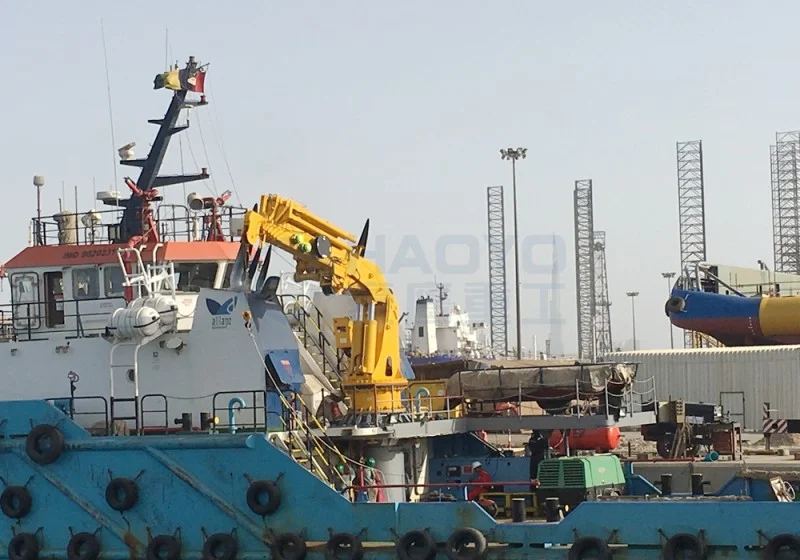In modern marine engineering and shipping operations, telescopic arm marine cranes, with their exceptional flexibility, reach, and spatial adaptability, have become an indispensable component of ship lifting equipment. Their flexible boom extension and retraction accommodate varying lifting distances and loads, making them widely used on a variety of vessels, including offshore platforms, cargo ships, engineering vessels, and fishing vessels. However, the efficient and safe operation of this type of equipment depends on the operator's strict adherence to operating regulations and thorough assessment of potential risks.
This article will systematically explain the precautions for using telescopic arm marine cranes, covering pre-startup inspections, precautions during operation, requirements for operating in special environments, safety precautions, and routine maintenance, to help you achieve safe, efficient, and long-term operation.
1. Pre-operation Inspection and Preparation:
Before commencing lifting operations, operators should conduct a comprehensive inspection of the equipment according to standard procedures. As high-load, high-intensity equipment, telescopic arm marine cranes require all structural components and control systems to be in perfect condition.
1.1 Checking the Hydraulic System
The hydraulic system is the heart of the telescopic arm marine crane, controlling extension, slewing, and hook movement. Before use, focus on checking for sufficient hydraulic oil, smooth operation of the oil pump, leaks or signs of aging in the hydraulic lines, and valve sensitivity.
1.2 Check the boom and connecting parts for looseness or cracks
The connecting bolts and pins between the telescopic boom sections must be tightened. Any looseness can cause a safety accident during lifting. Also, check the boom for cracks, bends, or corrosion, especially on vessels operating in high salt spray environments.
1.3 Test the responsiveness of the electrical and control systems
This includes the remote control, operating console, alarm system, limit switches, and all buttons and indicators. Ensure proper operation to avoid misoperation or control failure.
1.4 Check the wire rope and pulley system
Check whether the wire rope is broken, deformed, or rusted. Does the pulley rotate smoothly? Is the hook locked? These are all key components that must be verified.

2. Operating Procedures to Be Observed During Operation
Even if the equipment has been inspected and found to be intact, every action must be performed accurately during the actual lifting operation. Any negligence in the details can result in personal injury or equipment damage. 2.1 Control telescopic movements smoothly and slowly.
When retracting or extending a telescopic boom, avoid sudden acceleration or sudden stops. Especially during high-altitude lifting operations, sudden boom movement can easily cause the load to sway, increasing difficulty and risk.
2.2 Overloading is strictly prohibited.
Each telescopic boom marine crane has a specific rated load limit at different boom lengths. Operators must refer to the load curve chart based on the current boom length and slewing angle. Never overload the crane for the sake of efficiency.
2.3 Perform a test lift before lifting.
A test lift can check the stability of the lifting point and the balance of the load. This is especially true when lifting objects with irregular shapes or offset centers of gravity. Test lifts can help identify any problems and allow adjustments to be made in advance.
2.4 Maintain good visibility and communication.
Operators must maintain good visibility and communicate with their colleagues using video surveillance or an intercom system to avoid blind lifting. 2.5 Prohibit Standing or Walking Under the Telescopic Boom
The operation area should be clearly marked with warning signs. Personnel are strictly prohibited from moving directly under the boom or within the operating area to prevent injury from sudden falls.
3. Precautions for Operations in Special Environments
Marine cranes are often exposed to harsh environments such as wind, waves, rain, snow, high humidity, and high salt spray. The telescopic boom structure and operating procedures must be adapted to these conditions.
3.1 Suspend Operations in Severe Sea Conditions
When encountering winds of force 6 or above, strong waves, or dense fog, hoisting operations should be suspended immediately to prevent the load from swaying and causing unhooking or the crane to capsize.
3.2 Pay Attention to Anti-Slip and Electrical Safety in Rainy and Snowy Weather
The operating platform and deck should be anti-slip to prevent operators from falling. All electrical control systems must be well sealed and waterproof to prevent short circuits.
3.3 Pay Attention to Corrosion Protection in High Salt Spray Environments
For telescopic boom marine cranes used at sea for extended periods, it is recommended that the boom and key metal parts be treated with anti-corrosion coatings, hot-spray zinc treatment, and other corrosion-resistant treatments. Regular flushing and desalination should also be performed.
4. Safety Devices Must Not Be Ignored
Modern telescopic boom marine cranes are generally equipped with multiple safety protection systems. Operators must be familiar with and master their use.
4.1 Lifting Limiter
Prevents over-lifting or over-lowering, protecting the wire rope and hook.
4.2 Overload Protection System
If the load exceeds the rated load, the system automatically issues an alarm and stops operation, making it a key device for preventing accidents.
4.3 Boom Length and Lifting Torque Limiter
By real-time monitoring of the relationship between boom length and lifting capacity, it ensures that torque limits are not exceeded due to excessive boom extension.
4.4 Emergency Stop Button
In the event of an emergency, the operator can immediately press the "Emergency Stop" button to quickly terminate all operations and prevent escalation of the accident.
5. Daily Maintenance and Regular Inspection Recommendations
To ensure the long-term safe operation of the equipment, daily maintenance and regular servicing are essential and cannot be ignored.
5.1 Daily Inspection
This includes checking the hydraulic oil level, electrical control system, wire rope wear, and cracks on the boom surface. 5.2 Monthly Maintenance
Clean the hydraulic system filter, check the motor and pump operation, and add grease.
5.3 Perform comprehensive maintenance quarterly or semi-annually.
Inspect welds, structural components, control system sensitivity, and the integrity of the anti-corrosion coating. Contact a professional for repair if necessary.
5.4 Maintain a Maintenance Log
Every inspection, troubleshooting, and part replacement should be recorded to provide a basis for future repairs.
As a vital lifting equipment on modern ships, the safe and efficient operation of telescopic boom marine cranes depends on the operator's understanding of equipment performance, adherence to operating procedures, and attentive maintenance. Only by understanding the equipment, operating it effectively, and diligently maintaining it can the equipment be ensured to operate stably and forge ahead, avoiding unnecessary accidents and losses.
If you are a marine equipment operator, a project manager for an engineering vessel, or a purchaser of marine lifting equipment, we hope this user guide will provide you with a useful reference. Furthermore, selecting a crane supplier with experience and comprehensive after-sales service is crucial to ensuring equipment quality and a positive user experience. If you require customized telescopic boom marine cranes of varying specifications, or require more detailed technical manuals and operator training materials, please contact us for professional support.
As a professional telescopic boom marine crane company, we are committed to providing high-performance, highly reliable lifting solutions for all types of vessels. Leveraging our extensive industry experience and technical expertise, we not only offer customized products in a variety of specifications, but also provide customers with one-stop support from model selection consultation, installation and commissioning, operator training, and after-sales service, ensuring stable, safe, and efficient operation of our equipment in complex sea conditions. Choosing us means choosing professional support and long-term partnership.
www.haoyotech.com
haoyotech
About Author
You may also like
-
Ground Solar Mounting System: A Reliable Foundation for Large-Scale Solar Installations
-
PM High-Speed Motors: Driving Efficiency and Precision in Advanced Industrial Systems
-
Cable Hollow Winder Launched with Rapid Operation
-
What Is an Explosion Proof Motor and How Does It Work?
-
The Role of Electrofusion Fittings in Leak-Free Water and Gas Networks
